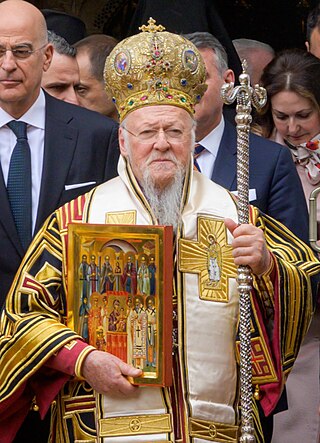
The Ecumenical Patriarch of Constantinople is the archbishop of Constantinople and primus inter pares among the heads of the several autocephalous churches that comprise the Eastern Orthodox Church. The ecumenical patriarch is regarded as the representative and spiritual leader of the Eastern Orthodox Christians worldwide. The term ecumenical in the title is a historical reference to the Ecumene, a Greek designation for the civilised world, i.e. the Roman Empire, and it stems from Canon 28 of the Council of Chalcedon.

The Empire of Trebizond or the Trapezuntine Empire was one of the three successor rump states of the Byzantine Empire that existed during the 13th through to the 15th century. The empire consisted of the Pontus, or far northeastern corner of Anatolia, and portions of southern Crimea.
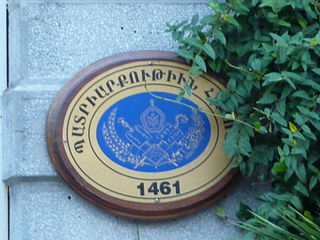
The Armenian Patriarchate of Constantinople is an autonomous see of the Armenian Apostolic Church. The seat of the Armenian Patriarch of Constantinople, also known as Armenian Patriarch of Istanbul, is the Surp Asdvadzadzin Patriarchal Church in the Kumkapı neighborhood of Istanbul.

The Byzantine Empire experienced cycles of growth and decay over the course of nearly a thousand years, including major losses during the early Muslim conquests of the 7th century. But the Empire's final decline started in the 11th century, and ended 400 years later in the Byzantine Empire's destruction in the 15th century.
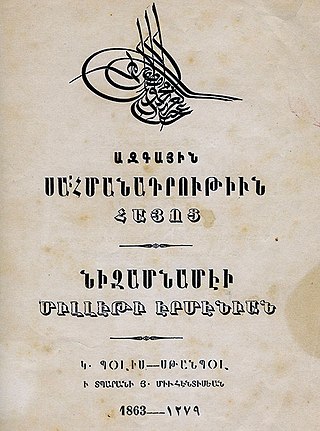
The Armenian National Constitution or Regulation of the Armenian Nation was a constitution in the Ottoman Empire for members of the Gregorian Armenian Millet. Promulgated in 1863, it defined the powers of the Armenian Patriarch, a newly formed Armenian National Assembly, and lay members. This code is still active among Armenian Church in diaspora. The Ottoman Turkish version was published in the Düstur. Other constitutions were promulgated for the Catholic Armenian and the Protestant Armenian millets.
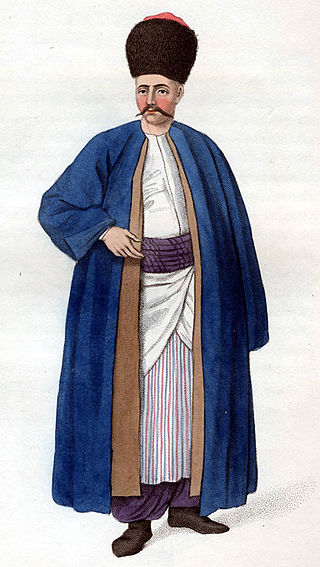
Armenians were a significant minority in the Ottoman Empire. They belonged to either the Armenian Apostolic Church, the Armenian Catholic Church, or the Armenian Protestant Church, each church serving as the basis of a millet. They played a crucial role in Ottoman industry and commerce, and Armenian communities existed in almost every major city of the empire. The majority of the Armenian population made up a reaya, or peasant, class, in Eastern Anatolia. The Tanzimat reforms in the nineteenth century sought to manifest the doctrine of equality before the law. Despite their importance, Armenians were persecuted by the Ottoman authorities, especially from the latter half of the 19th century, culminating in the Armenian Genocide.

Catholicos Karapet II Oolnetzi was the Catholicos of the Armenian Apostolic Church between 1726 and 1729.

The Patriarchate of Cilicia is an ecclesiastical jurisdiction and the only patriarchate of the Armenian Catholic Church of the Catholic Church. The territorial jurisdiction of the Patriarch of Cilicia is the Archeparchy of Beirut, over which the Patriarch of Cilicia holds ordinary authority. The St. Elie and St. Gregory the Illuminator Armenian Catholic Cathedral in Beirut, Lebanon, is the cathedra of the Patriarchate. The Patriarchate is headed by Patriarch Raphaël Bedros XXI Minassian elected in September 2021.

In AD 1453, the city of Constantinople, the capital and last stronghold of the Byzantine Empire, fell to the Ottoman Empire. By this time Egypt had been under Muslim control for some eight centuries. Jerusalem had been conquered by the Rashidun Caliphate Muslims in 638, won back by Rome in 1099 under the First Crusade and then reconquered by Saladin's forces during the siege of Jerusalem in 1187. Later in the seventh Crusade, it was briefly taken back by the Catholics once again. It was conquered by the Ottomans in 1517. Orthodoxy, however, was very strong in Russia which had recently acquired an autocephalous status; and thus Moscow called itself the Third Rome, as the cultural heir of Constantinople. Under Ottoman rule, the Greek Orthodox Church acquired power as an autonomous millet. The ecumenical patriarch was the religious and administrative ruler of the entire "Greek Orthodox nation", which encompassed all the Eastern Orthodox subjects of the Empire.

Holy See–Turkey relations are foreign relations between the Holy See and Turkey. Both countries established diplomatic relations in 1868, originally between the Holy See and the Ottoman Empire. The Holy See has a nunciature in Ankara. Turkey has an embassy in Rome.

The Sword of Osman was an important sword of state used during the enthronement ceremony of the sultans of the Ottoman Empire, from the accession of Murad II onwards. This particular type of enthronement ceremony was the Ottoman variant of the Bay'ah. The sword was named after Osman I, founder of the Ottoman dynasty.
Gabriel II was Ecumenical Patriarch of Constantinople for one week in 1657.
Mark II Xylokaravis was Ecumenical Patriarch of Constantinople from 1465 to 1466. In 1467 he became Archbishop of Ohrid, a post he held until his death.
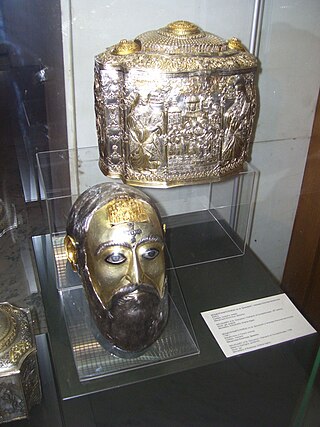
Dionysius I was Ecumenical Patriarch of Constantinople two times, from 1466 to 1471 and from 1488 to 1490. He is honoured as a saint in the Eastern Orthodox Church and his feast day is November 23.
Symeon I of Trebizond was Ecumenical Patriarch of Constantinople three times: for a short time in 1466, from 1471 to 1475 and from 1482 to 1486. In 1484 he presided over the Synod of Constantinople of 1484 which repudiated the Union of Florence.
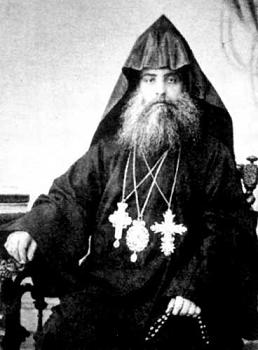
Matthew II Izmirlian was the Catholicos of All Armenians of the Armenian Apostolic Church at the Mother See of Holy Etchmiadzin in 1908–1910. He succeeded Mkrtich I Khrimian, who reigned as Catholicos from 1892 to 1907.
Patriarchate of Constantinople generally refers to the Ecumenical Patriarchate of Constantinople, the seniormost authority in the Eastern Orthodox Church, led by the Ecumenical Patriarch of Constantinople. The diocese of Constantinople is alleged to have originated with Andrew the Apostle's visit in 38, and has been formally designated as Patriarchate since 531. Its seat is the city successively known as Byzantium, Constantinople, and now Istanbul, Turkey.
The Siege of Kulacahisar or Raid of Kulacahisar was a battle fought between the Byzantines and the Turks under the command of Osman Gazi in 1285 for control of Fort Kulaca.
Anton Bogos Çelebi was an Armenian merchant magnate and Ottoman and later Tuscan official in 17th century. Gonfalonier of Livorno. He was a brother of Hasan Agha.













